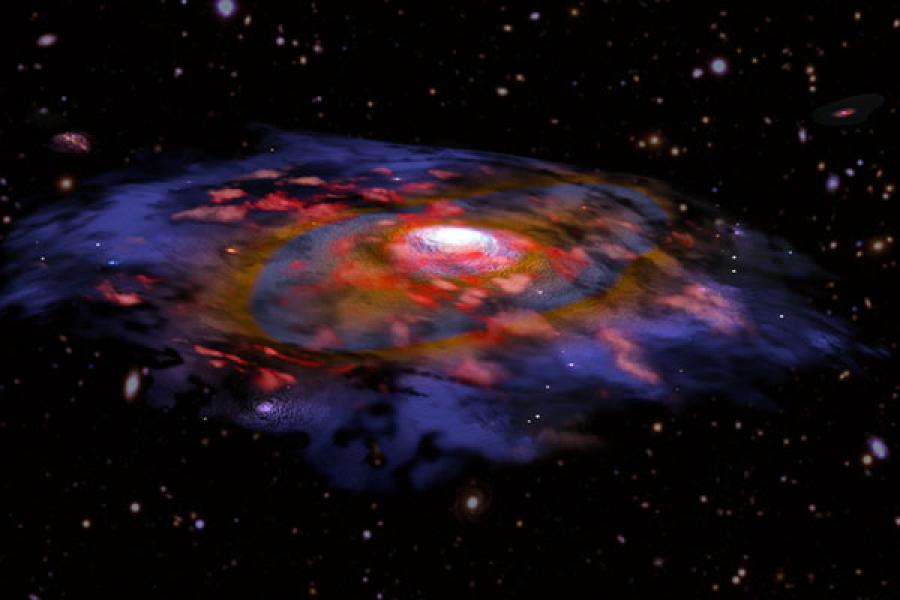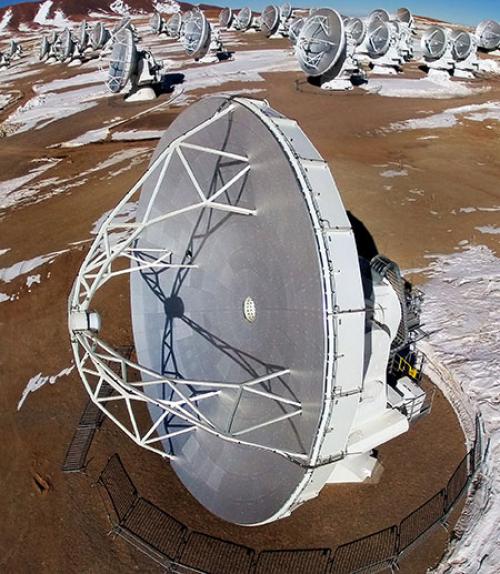An international team of astronomers — including the research group of Cornell astronomer Dominik Riechers — has obtained profound new insight into the nature of galaxies in the early universe and how they formed their stars across cosmic history. The team found that galaxies likely started forming their stars only about 200 million years after the Big Bang and that they were already fairly mature less than one billion years later.
Using large quantities of observing time on the Atacama Large sub/Millimeter Array (ALMA), the research team, dubbed ALPINE (the ALMA Large Program to Investigate C+ at Early Times), looked at 118 galaxies to reach their conclusion that massive galaxies were already much more mature in the early universe than previously expected.
Most galaxies formed when the universe was still very young. (Our own galaxy likely started forming 13.6 billion years ago, in our 13.8 billion-year-old universe.) Galaxies are considered more “mature” than “primordial” when they contain a significant amount of dust and heavy elements, which are considered to be the by-products of dying stars. But galaxies in the early universe have not had much time to build stars yet, so astronomers didn’t expect to see much dust or heavy elements. The ALPINE team, however, found that around 20 percent of the galaxies they studied from this early epoch were already hidden by dust.
The galaxies also appeared more mature than expected because of the diversity in their structures, including the first signs of rotationally supported disks, which may lead to galaxies with a spiral structure such as our Milky Way. Astronomers generally expect that galaxies in the early universe look like more like train wrecks, because they often collide.
The scientists don’t yet fully understand how these galaxies grew up so fast or why some of them already have rotating disks.
nrao20in15d-1024x576-x-600.jpg
The ALPINE study was critically enabled by Riechers and his team's initial demonstrations that studies of the star formation properties of faint, very distant galaxies were possible with a telescope as sensitive as ALMA. Riechers’ initial observations were obtained with only about a third of the capabilities that ALMA now offers.
“The ALPINE survey really allowed us to push our initial results to the next level now that ALMA has unfolded its full potential,” said Riechers, assistant professor of astronomy in the College of Arts and Sciences.
Riccardo Pavesi M.S. ’15, Ph.D. ‘19, a member of Riechers’ team, has carried out some of the most detailed studies to date of these early galaxies using ALMA and the Karl G. Jansky Very Large Array.
"It is exciting to see that my involvement in the early planning stages of ALPINE has been so fruitful," said Pavesi. "We now finally know that our initial findings were not a coincidence, but that it rather seems to be the norm for galaxies to mature quite rapidly at these early epochs."
Added Riechers, “The results from ALPINE are fantastic news for a large survey program we have designed for the Fred Young Submillimeter Telescope (FYST, formerly CCAT-prime), which will target the same diagnostic lines across the large-scale structure of the universe." The survey will be carried out with the EoR-Spec spectrometer, which is funded by the National Science Foundation and currently under construction in the Department of Astronomy.
FYST, being built for an exceptional high-elevation site in Chile by a consortium of U.S., German and Canadian academic institutions led by Cornell, is designed to quickly map large areas of the sky at submillimeter and millimeter wavelengths and acts like a wide-angle lens to ALMA’s close-up view.. These wavelengths can give unprecedented insights into how the first galaxies “lit up” the universe during “Cosmic Dawn,” a few hundred million years after the Big Bang.





